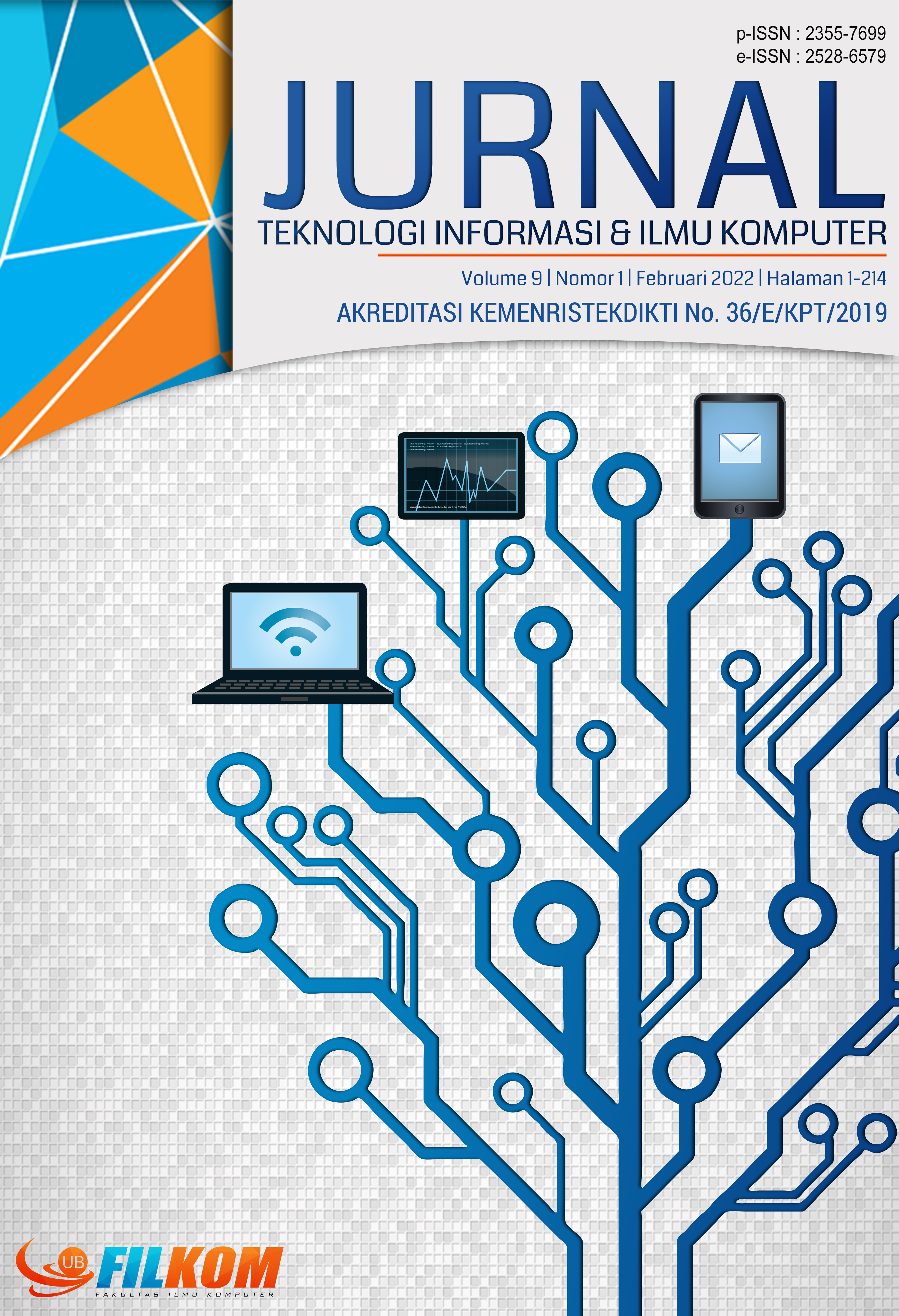Perancangan User Experience Aplikasi E-Business Pasar Tradisional Dengan Metode Human Centered Design (Studi Kasus: Pasar Oro-Oro Dowo)
DOI:
https://doi.org/10.25126/jtiik.2022915592Abstrak
Penyebaran COVID-19 di Indonesia mengakibatkan penurunan transaksi pada pasar tradisional, hal ini dikarenakan adanya penurunan jumlah pengunjung dan minat beli serta minat beli masyarakat secara luas. Salah satu pasar tradisional yang terdampak adalah Pasar Oro-oro Dowo Kota Malang. Untuk tetap mempertahankan transaksi di pasar, pedagang Pasar Oro-oro Dowo menggunakan aplikasi WhatsApp untuk menawarkan barangnya, selain itu ada pula solusi yang ditawarkan Pemerintah Kota yakni menyediakan sarana untuk jual beli secara online. Namun solusi tersebut belum mampu memberikan pengalaman penggunaan yang mudah serta adanya beberapa fungsi yang masih terpisah dari platform utama membuat solusi tersebut kurang efektif. Oleh karena itu, melalui penelitian ini diusulkan rancangan aplikasi e-business pasar berdasarkan penerapan elemen UX dengan menggunakan pendekatan Human-Centered Design. Hasil dari penelitian berupa tiga prototype yang diujikan kepada tiga kelompok pengguna yakni pembeli, pedagang, dan admin pasar. Pengujian rancangan prototype aplikasi tersebut dilakukan dengan pendekatan usability testing yang mengukur aspek efektivitas, efisiensi dan kepuasan pengguna. Skor efektivitas dari aplikasi pedagang, pembeli dan admin berturut-turut sebesar 100%, 98% dan 100%. Sedangkan skor efisiensi berturut-turut sebesar 100%, 97,03% dan 100%. Dalam pengujian aspek kepuasan pengguna, kuesioner yang digunakan adalah PSSUQ dengan hasil skor sebesar 2,0 pada aplikasi pedagang, 2,15 pada aplikasi pembeli dan 1,11 pada website admin.
Abstract
A covid-19 pandemic causes the decrease of transactions in the traditional market. This is due to the decrease in the number of visitors and public purchase intention extensively. One of the markets affected is Oro-Oro Dowo Market in Malang City. To maintain the transaction in the market, the sellers in Oro-Oro Dowo Market use the WhatsApp application to offer their items. Moreover, the solution offered by the City Government is by providing a platform for the online transaction. However, the solution has not been able to provide an easy user experience, and several functions that are still separated from the main platform make this solution less effective. Therefore, through this study, the user experience design of the conventional market e-business application using Human-Centered Design is proposed. The results of the study are in the form of three prototypes that are tested to three user groups, buyer, seller, and market admin. The testing for application prototype design is conducted by usability testing approach, which measures the effectiveness, efficiency, and user satisfaction aspects. The effectiveness score of seller, buyer, and admin applications are 100%, 98%, and 100%, respectively. Meanwhile, the efficiency score is 100%, 97.03%, and 100%, respectively. In testing the user satisfaction aspect, the questionnaire used is PSSUQ with a score of 2.0 in seller application, 2.15 in buyer application, and 1.11 in admin website.
Downloads
Referensi
ANDIKA, R., PRATIWI, S., ANISA, A. & PUTRI, S. A., 2020. Dampak COVID-19 Terhadap Pendapatan Pedagang Mikro Pada Pasar Tradisional. Jurnal Ekonomi Islam, 1(1), pp. 16-22.
GARETT, J. J., 2011. The Element of User Experience: User-Centered Design for the Web and Beyond. 2nd penyunt. Berkeley, CA: New Riders.
GRIFFITHS, S., 2015. Mobile App UX Principle. [Online]
Available at: https://storage.googleapis.com/think-emea/docs/article/Mobile_App_UX_Principles.pdf
[Diakses 8 Januari 2021].
HAMED, R., 2019. Research Gate. [Online]
[Diakses 21 Mei 2021].
ISO, 2010. Human-centered Design for Interactive System. ISO 9241-210:2010(E), 30(1), pp. 1-32.
LEAVITT, M., 2006. Research Based Web Design and Usability Guidelines. s.l.:U.S. Department of Health and Human Services.
LEE, J. H., KIM, J. M. & KIM, S. W., 2015. A Study Customer Journey Map for User Experience Analysis of Information and Communications Technology Service. International Conference of Design, User Experience, and Usability. DUXU 2015: Design, User Experience, and Usability: Users and Interactions pp, Volume 9187, pp. 66-74.
MATERIAL, D., 2020. Material Design. [Online]
Available at: https://material.io/components
[Diakses 20 November 2020].
MIFSUD, 2015. Usability Metrics – A Guide To Quantify The Usability Of Any System. [Online]
Available at: https://usabilitygeek.com/usability-metrics-a-guide-to-quantify-system-usability/
[Diakses 20 Maret 2021].
NIATI, U., SURATNO, T. & MAULADI, 2019. Perancangan Dan Evaluasi Sistem Transaksi Online Pasar Tradisional Perancangan Dan Evaluasi Sistem Transaksi Online Pasar Tradisional. Jurnal Sains dan Sistem Informasi (JUSS), 2(1), pp. 20-27.
RIFQI, A., MURSYITO, Y. & AZ-ZAHRA, H., 2019. Pengembangan Sistem Informasi Pengelolaan Nilai Siswa Menggunakan Metode Human Centered Design (Studi Pada SMP Negeri 1 Gondanglegi). Jurnal Pengembangan Teknologi Informasi dan Ilmu Komputer, 3(2), pp. 2061-2069.
SABARIAH, M. K., EFFENDI, V. & ICHSAN, M. F., 2016. Implementation of Hierarchical Task Analysis for User Interface Design in Drawing Application for Early Childhood Education. Journal of Education and Learning, X(2), pp. 159-166.
SAURO, J. & LEWIS, J. R., 2016. Quantifying The User Experience Practical Statistic for User Research. 2nd penyunt. Cambridge, MA: Morgan Kauffman.
SERGEEV, 2010. UI Designer. [Online]
Available at: http://ui-designer.net/usability/effectiveness.htm
[Diakses 20 March 2021].
SETIADI, D., MUHAEMIN, M. N. A. & AKBAR, Y. H., 2020. Aplikasi Pasagi (Pasar Sumedang Go Online) Solusi Belanja Dimasa PSBB. Jurnal Teknologika, 10(2).
SMITH, B., CHATFIELD, V. & UEMURA, O., 2001. IBM iSeries e-business Handbook:A V5R1 Technology and Product Reference. s.l.:IBM Redbooks.
WHITENTON, K., 2017. Tree Testing: Fast, Iterative Evaluation of Menu Labels and Categories. [Online]
Available at: https://www.nngroup.com/articles/tree-testing/
[Diakses 18 Februari 2021].
.
Unduhan
Diterbitkan
Terbitan
Bagian
Lisensi

Artikel ini berlisensi Creative Common Attribution-ShareAlike 4.0 International (CC BY-SA 4.0)
Penulis yang menerbitkan di jurnal ini menyetujui ketentuan berikut:
- Penulis menyimpan hak cipta dan memberikan jurnal hak penerbitan pertama naskah secara simultan dengan lisensi di bawah Creative Common Attribution-ShareAlike 4.0 International (CC BY-SA 4.0) yang mengizinkan orang lain untuk berbagi pekerjaan dengan sebuah pernyataan kepenulisan pekerjaan dan penerbitan awal di jurnal ini.
- Penulis bisa memasukkan ke dalam penyusunan kontraktual tambahan terpisah untuk distribusi non ekslusif versi kaya terbitan jurnal (contoh: mempostingnya ke repositori institusional atau menerbitkannya dalam sebuah buku), dengan pengakuan penerbitan awalnya di jurnal ini.
- Penulis diizinkan dan didorong untuk mem-posting karya mereka online (contoh: di repositori institusional atau di website mereka) sebelum dan selama proses penyerahan, karena dapat mengarahkan ke pertukaran produktif, seperti halnya sitiran yang lebih awal dan lebih hebat dari karya yang diterbitkan. (Lihat Efek Akses Terbuka).








